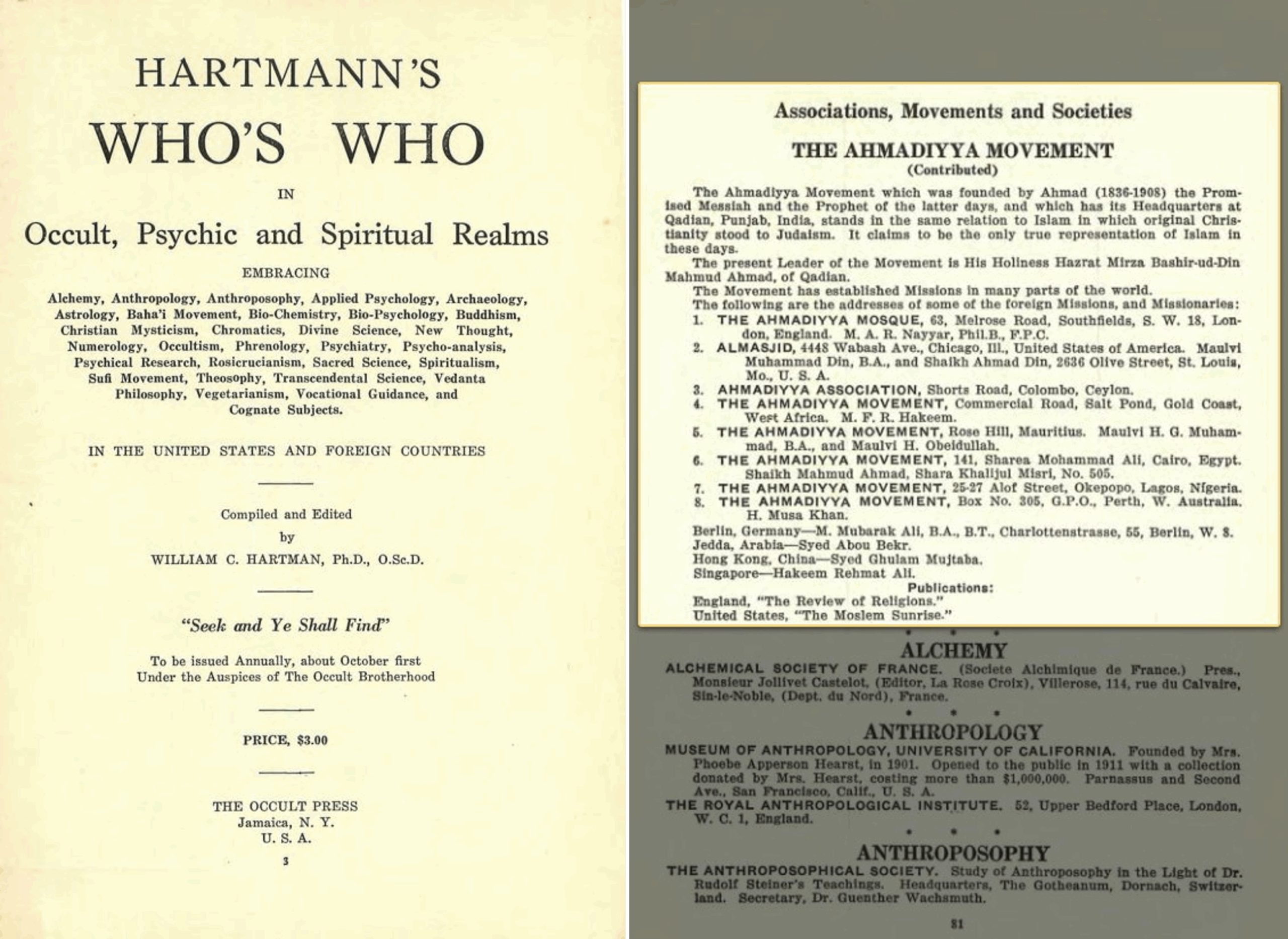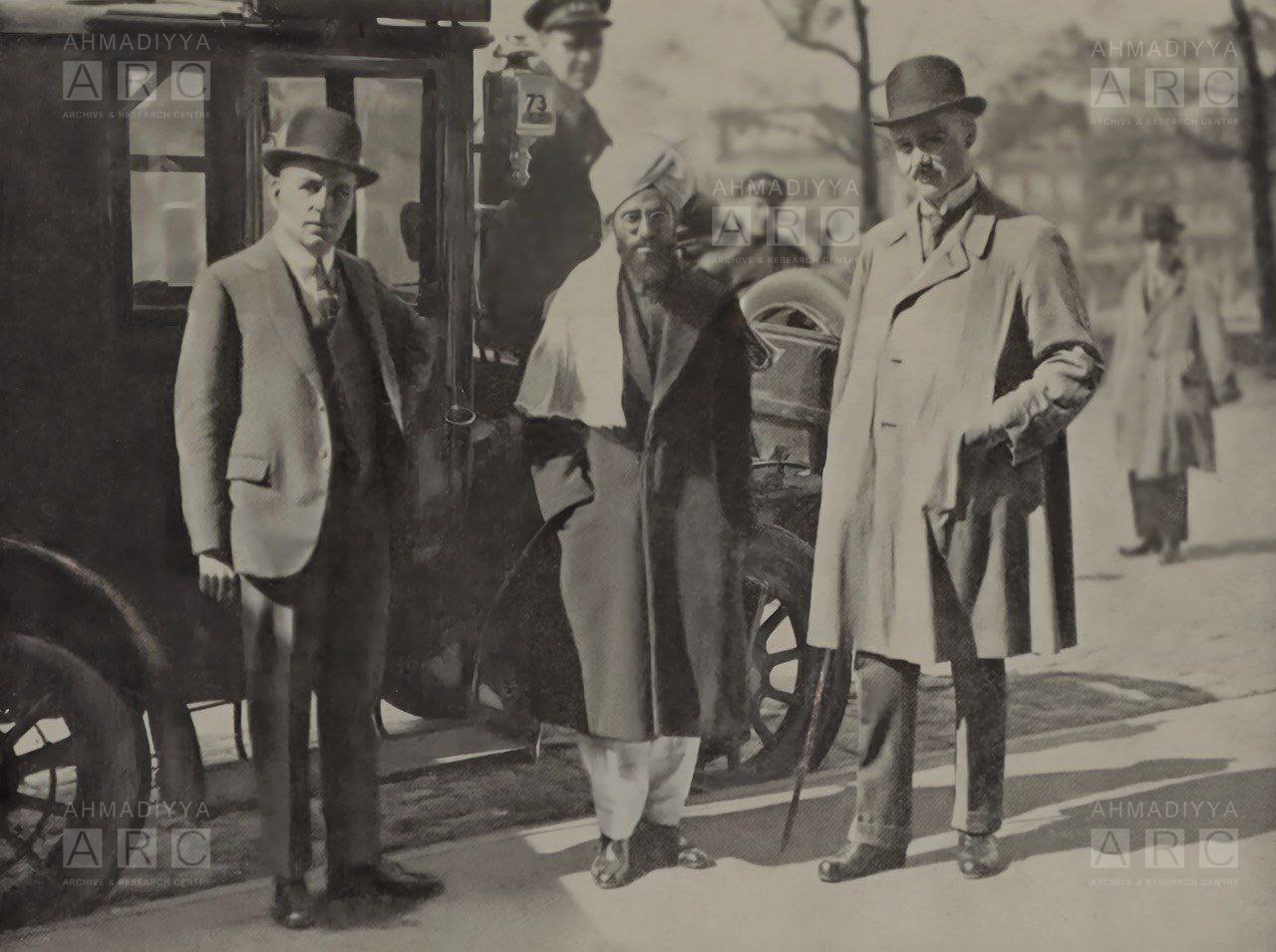Ata-ul-Haye Nasir, Ahmadiyya Archive & Research Centre

At the Ahmadiyya Archive & Research Centre, we are always on the lookout for historical accounts that shed light on the early days of the Ahmadiyya Muslim Jamaat.
It was interesting to find that in November 1925, exactly a hundred years ago, a book was published in America, titled Hartmann’s Who’s Who in Occult, Psychic and Spiritual Realms, authored by William C Hartmann, PhD, OScD.
The author and the book
William C Hartmann Sr, PhD, OScD, was born in Germany in 1870. His family later immigrated to the USA in 1881. Hartmann passed away in 1953.
In addition to the book under discussion, he published many other works, including one in 1930, titled Hartmann’s International Directory of Psychic Science and Spiritualism. According to the Journal of the American Society for Psychical Research, Hartmann was the founder of The Survival League of America.1
In his book, titled Hartmann’s Who’s Who in Occult, Psychic and Spiritual Realms, William C Hartmann introduced various religious movements, their publications and missionaries serving in different parts of the world.
He included an introduction to the Promised Messiahas, Hazrat Khalifatul Masih IIra, periodicals of the Jamaat and the Ahmadi missionaries serving around the world.

A couple of months prior to the book’s publication, a Canadian newspaper, The Hamilton Spectator, provided some details about this upcoming book in the following words:
“The Occult Press, Jamaica, N.Y., is about to publish, under the auspices of the Occult Brotherhood, a volume entitled Who’s Who in Occult, Psychic and Spiritual Realms, compiled and edited by William C. Hartmann. The work will contain a list of American and foreign periodicals relating to the occult, a directory of organizations and societies, a list of schools, colleges and instructors in arcane studies, a general alphabetical list of practitioners of all branches of the occult sciences, and other information of a similar nature.”2
The Occult Press would publish a monthly journal called The Occult Digest and its October 1925 issue included an announcement mentioning that they were in the process of publishing the book containing “thousands of listings of Associations, Organisations and Societies, with Declarations of Principles, Objects, Officers and Auxiliaries of the more prominent ones.”3
One of Hartmann’s collaborators, Dr Guy Bogart of Los Angeles, wrote an introduction to this book, in which he stated:
“Mr. Hartmann is server indeed in pioneering in this biggest definite step yet taken in a concrete way to show us to ourselves as a great diversified family.” Bogart further wrote that “never has anything of like magnitude been attempted in this field.”4
Introduction to the Promised Messiahas and Khilafat
The introduction to the Ahmadiyya Muslim Jamaat was given under the heading “Associations, Movements and Societies”.
The Jamaat’s introduction was entitled “The Ahmadiyya Movement”. In the line below this title was written the word “Contributed”, which suggests that upon the request of the author, a representative of the Jamaat provided some details about the Ahmadiyya Muslim Jamaat, a summary of which was then incorporated into the book.
This was followed by a detailed introduction of the Jamaat, beginning with the mention of the Promised Messiahas and Hazrat Musleh-e-Maudra in the following words:
“The Ahmadiyya Movement, which was founded by Ahmad[as] (1836-1908), the Promised Messiah and the Prophet of the Latter Days, and which has its Headquarters at Qadian, Punjab, India, stands in the same relation to Islam in which original Christianity stood to Judaism. It claims to be the only true representation of Islam in these days.
“The present Leader of the Movement is His Holiness Hazrat Mirza Bashir-ud-Din Mahmud Ahmad[ra], of Qadian.”5
A list of Ahmadiyya Missions

William C Hartmann then mentioned that the Ahmadiyya Movement “has established Missions in many parts of the world”, which was followed by “the addresses of some of the foreign Missions, and Missionaries”. These addresses were listed as follows:
“1. The Ahmadiyya Mosque, 63, Melrose Road, Southfields, S.W.18, London, England. M.A.R. Nayyar, Phil.B., F.P.C
“2. AlMasjid, 4448 Wabash Ave., Chicago, Ill., United States of America. Maulvi Muhammad Din, B.A., and Shaikh Ahmad Din, 2636 Olive Street, St. Louis, Mo., U.S.A.
“3. Ahmadiyya Association, Shorts Road, Colombo, Ceylon.
“4. The Ahmadiyya Movement, Commercial Road, Salt Pond, Gold Coast, West Africa. M.F.R. Hakeem.
“5. The Ahmadiyya Movement, Rose Hill, Mauritius. Maulvi H.G. Muhammad, B.A., and Maulvi H. Obeidullah.
“6. The Ahmadiyya Movement, 141, Sharea Mohammad Ali, Cairo, Egypt. Shaikh Mahmud Ahmad, Shara Khalijul Misri, No. 505.
“7. The Ahmadiyya Movement, 25-27 Alof Street, Okepopo, Lagos, Nigeria.
“8. The Ahmadiyya Movement, Box No. 305, G.P.O., Perth, W. Australia. H. Musa Khan.
“Berlin, Germany – M. Mubarak Ali, B.A., B.T., Charlottenstrasse, 55, Berlin, W. 8.
“Jedda, Arabia – Syed Abou Bekr.
“Hong Kong, China – Syed Ghulam Mujtaba.
“Singapore – Hakeem Rehmat Ali.”6

Ahmadiyya periodicals
Among the publications of the Jamaat, The Review of Religions and The Moslem Sunrise were mentioned.7
At another place in that book, Hartmann gave a list of prominent periodicals all over the world. Under the subheading “United States”, he listed The Moslem Sunrise, and wrote:
“The Moslem Sunrise. 4448 South Wabash Avenue, Chicago, Ill. Quarterly. Editor, Prof. Maulvi Muhamad Din, Mohammedan Missionary of Ahmadia Movement in Islam.”8
Under the subheading “England”, he included The Review of Religions and wrote:
“The Review of Religions. Editors, Mirza Bashir Ahmad, M.A., Qadian, India, and A.R. Dard, M.A., London. The Ahmadiyya Mosque, 63, Melrose Rd., Southfields, S.W.18, London.”9
Dard Sahibra among the ‘Prominent Officials of Societies’

William C Hartmann also provided a list of “Prominent Officials of Societies, Editors of Periodicals, Leaders of Different Movements, Etc.”
In this list, he included Hazrat Maulvi Abdur Rahim Dardra, in the following words:
“Dart [sic., Dard], Abdur Rahim, M.A., M.R.A.S. Editor, ‘The Review of Religions,’ Imam, First London Mosque – 53 [sic., 63] Melrose Rd., S.W.18, London, England; also Qadian, Punjab, India.10
In short, Hartmann’s Who’s Who, which was published in America exactly a hundred years ago, served as a means to spread the name and claims of the Promised Messiahas.
By mentioning the details of various Ahmadiyya missions around the world and the Jamaat’s periodicals, the book depicted the growth of the Ahmadiyya Muslim Jamaat in all corners of the world.
Endnotes
1. Journal of the American Society for Psychical Research, Vol. XXV, Number 4, April 1931, p. 175
2. The Hamilton Spectator, 12 September 1925, p. 24
3. The Occult Digest, October 1925, p. 48
4. Hartmann’s Who’s Who in Occult, Psychic and Spiritual Realms, The Occult Press, November 1925, USA, p. 7
5. Ibid., p. 81
6. Ibid.
7. Ibid.
8. Ibid., p. 47
9. Ibid., p. 51
10. Ibid., p. 14

